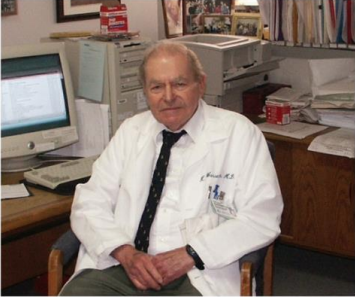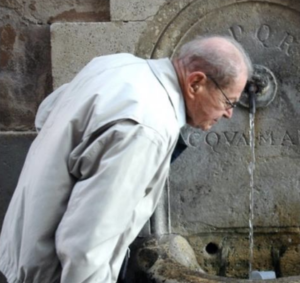Professor Karlman Wasserman(1927 – 2020) |
Professor Brian Whipp(1937 – 2011) |
 |
 |
The names Wasserman and Whipp trip off the tongue rather like ‘strawberries and cream’.
The story of this productive team starts at the University of California, San Francisco when Karl began working with Professor Julius Conroe in 1959. There he published the first paper on the anaerobic threshold and exercise with Malcolm McIlroy in 1964 (1) . Karl was subsequently appointed to the faculty at Stanford where he worked with William L. Beaver, PhD to lay the framework for exercise testing with the development of the first system for real-time breath-by-breath analysis of respiratory function (2) . At that time a new graduate student, Brian Whipp, a Welshman, joined Karl’s laboratory. Brian whilst there obtained his PhD in the Department of Physiology under Karl’s mentorship. Later, in 1967, Karl accepted the position of Professor of Medicine and Chief of the Division of Respiratory Physiology and Medicine at Harbor-UCLA Medical Center. He led a thriving research program that was continuously funded by the National Institute of Health for nearly 30 years. Brian moved to Harbor with him, as a National Institutes of Health Postdoctoral Research Fellow. These two men worked together for decades and, amongst other accomplishments continued to develop the science of cardiopulmonary exercise testing. The team of Wasserman and Whipp was effective because it brought together two scientists with complimentary skill sets. Karl recognized the importance of funding to the productivity of the laboratory, submitting applications for grant support. Karl was a trained physiologist that benefitted from insight as a physician into how exercise testing could be used to evaluate health and be used as a diagnostic tool in patients. Brian became a respected respiratory and exercise physiologist and was a gifted speaker that patiently rehearsed each point and concept important for emphasis in an oration. Brian was able to bring lessons of the laboratory to a classroom or lecture hall. Karl and Brian both received numerous academic awards for their work. About this time Dr D. Bruce Dill, the onetime director of the Harvard Fatigue Laboratory which closed in 1947, co-authored a paper with Karl regarding fitness at 90 years of age (3) . Karl was an avid runner having completed numerous marathons and half-marathons well into in his sixties. Karl also had a working contact with Professor August Krogh from Copenhagen. Among his many scientific achievements, Professor Krogh had set up what was probably the first ever exercise testing laboratory and had developed a bicycle ergometer with which he could accurately measure the weight of his subject during exercise. A detailed history of the development of the physiology behind measurement of oxygen uptake, from the time of Lavoisier, is available at http://www.cpxinternational.com/perspectives/ “Some facts and thoughts on history of oxygen uptake and its measurement.”
The first publication on the computer derivation of the anaerobic threshold non-invasively was by Beaver, Wasserman and Whipp in 1986 (4) . Later in 1986 they published related papers on bicarbonate buffering of lactic acid in exercise (5) and on intensity-dependent lactate profiles in exercise (6) . In 1987 a seminal book – “Principles of Exercise Testing and Interpretation” – was released about cardiopulmonary exercise testing (CPET) with Karl as the leading author (7) , which has affectionately become known as “PETI”. This book presented the now famous Wasserman 9-panel plot to analyze exercise test results across a wide range of clinical conditions. But it was not until 1997 that Karl published a paper detailing the interpretation of the 9-panel plot (8) . I do not intend that this article should become a chronicle of the published papers of Karl and Brian as this would amount to a canon covering skeletal muscle energetics, acid-base regulation and respiratory physiology during exercise in health and in cardiorespiratory diseases. I ask that you indulge me by allowing me to briefly mention three papers by Karl and his colleagues at Harbor. One was published in 1991 and is on the impact of CPET on clinical medicine (9) , A second, published in 1994, recognized that the lactic acidosis of exercise facilitated oxyhaemoglobin dissociation (10) (this has important connotations for the understanding of the importance of a lactic acidosis), and in 1997 on cardiac output determination via CPET (11) . Why have I singled out these papers? The co-authors of these papers, Professors Hansen, Casaburi, Stringer and Sue played key roles in CPET at Harbor and were co-authors together with Professors Wasserman and Whipp on subsequent editions of “PETI”. This book is now in its sixth edition (including several foreign language translations) – appropriately entitled “Wasserman & Whipp’s Principles of Exercise Testing and Interpretation” – albeit with some changes in co-authors and a new publisher (12) .
In 1997 Karl officially retired but remained actively involved in research and continued training domestic and international research fellows for another two decades. In 2002, Brian retired as Chair of the Department of Physiology at St George’s Hospital Medical School in London and remained active in research and education until his passing in 2011. In response to criticism from different sources that the Harbor group were over-emphasizing the issue of the anaerobic threshold, in 2008 Brian published a commentary on the validity of the term ‘anaerobic threshold’ (13) . Perhaps one of his more significant papers advanced understanding of skeletal muscle oxidative phosphorylation control in exercising humans (14) – involving the technically challenging feat of simultaneously determining the kinetics of intramuscular highenergy phosphate turnover and O2 uptake, which required substantial modification of breath-by-breath paradigms (hardware and software) for operation in the NMR environment. Brian, though, had many interests outside of physiology; he was an outstanding athlete in his youth and was a lover of classical music, Shakespeare and a keen trekker of the Welsh mountains around his home in Crickhowell.
At Harbor there was a weekly meeting of staff and fellows to discuss the progress of ongoing research, any papers that were being prepared for publication and also rehearsals of upcoming conference presentations. Karl and Brian alternated in leading these meetings and promoting discussions. In this way all the physicians and basic scientists in the group at Harbor during that time were mentored by Karl and Brian.
In 1997 a society was initiated and formed in Europe by Karl and a colleague from Germany, Dr. Winter. The society was given the name International Society for Exercise Intolerance Research and Education known by the acronym ISEIRE. Interest in a European Practicum was not surprising as Harbor was already running two teaching Practicums each year with attendees from all over the world. The first European Practicum was held in Essen, Germany. The Board of ISEIRE at that time was comprised of the researchers at Harbor with Karl as President and Brian as the exercise physiologist. It was a feature of that society to hold a teaching Practicum each year in different European cities. A full list of the venues and dates of these practicums is available at https://cpxinternational.com/category/practicum/practicums-earlier/ This society was incorporated as a charity in 2005. In 2009 the name ISEIRE was changed to CPX International and a website was set up. It is of note that both Karl and Brian opposed the name change. Karl was President of CPX International up to 2008. Upon completion of his tenure, Professor Agostoni assumed the role of President of CPX International in 2009 but Karl continued to lecture until 2012, at the London Practicum and Brian continued until 2010 in Bucharest.
Karl passed away in 2020 at his home in California. The last publication about Karl was to describe him as a “giant in chest medicine” (15), while one of Brian’s obituaries described him as “a master in respiratory and exercise physiology” (16) . There is one point often missed when discussing Karl and Brian; despite their status and seniority, they remained completely approachable and would answer any question, however basic, in a friendly and constructive manner. ‘Kings and commoners’ were treated in the same friendly and collegial manner.
| Karl during a casual moment during Rome Practicum 2007 | Brian relaxing on the Copacabana Rio de Janeiro South America Practicum 2008 |
 |
 |
References
- Wasserman K, McIlroy MB. Detecting the threshold of anaerobic metabolism in cardiac patients during exercise. Am J Cardiol 1964; 14: 844-52
- Beaver, W.L., K. Wasserman, and B.J. Whipp. On-line computer analysis and breath-by-breath graphical display of exercise function tests. J. Appl. Physiol. 34:128-132, 1973.
- Dill DB, Wasserman K. Fitness at Age 90: A New Record. Gerontologist 1964 Vol. 57 Pages 136-140
- Beaver WL, Wasserman K, Whipp BJ. A new method for detecting the anaerobic threshold by gas exchange. J Appl Physiol 1986; 60:2020-2027
- Beaver WL, Wasserman K, Whipp BJ. Bicarbonate buffering of lactic acid generated during exercise. J Appl Physiol 1986; 60: 472-478
- Wasserman K, Beaver WL, and Whipp BJ. Mechanisms and pattern of blood lactate increase during exercise in man. Med Sci Sports Ex 1986;18:344-3527)
- Wasserman K, Hansen JE, Sue DY, Whipp BJ. Principles of Exercise Testing and Interpretation; 1987: Publisher Philadelphia; Lea and Febiger
- Wasserman K. Diagnosing cardiovascular and lung pathophysiology from exercise gas exchange. Chest 1997; 112: 1091-1101
- Sue DY, Wasserman K. Impact of integrative cardiopulmonary exercise testing on clinical decision making Chest 1991; 99 Issue 4: 981-992
- Stringer W, Wasserman K, Casaburi R, Porszasz J, Maehara K , French W.Lactic acidosis as a facilitator of oxyhemoglobin dissociation during exercise J Appl Physiol 1994 ; 76: 1462-1467
- Stringer WW, Hansen JE, Wasserman K. Cardiac output estimated noninvasively from oxygen uptake during exercise Wasserman J Appl Physiol 1997; 82 Issue 3: 908-912
- Sietsema, K.E., D.Y. Sue, W.W. Stringer and S.A. Ward. Wasserman & Whipp’s Principles of Exercise Testing and Interpretation, 6th ed. WoltersKluwer: Philadelphia, 2020
- Whipp BJ. The anaerobic threshold: Yes, No, Maybe! in Physiological Basis of Human Performance during Work and Exercise Ed: Taylor NAS, Groeller H. Publisher Churchill Livingstone 2008, pp. 193-199
- Whipp BJ, Rossiter HB, Ward SA, Avery D, Doyle VL, Howe FA, Griffiths JR. 1999: Simultaneous determination of muscular high-energy phosphate and pulmonary O2 uptake kinetics during whole-body NMR spectroscopy. J Appl Physiol 86:742–747
- Kisaka T, Dumitrescu D, Rossiter HB, Sietsema KE. Giants in Chest Medicine: Karlman Wasserman, MD, PhD, FCCP Chest 2017; 151: 1209-1212
- Palange, P., R. Casaburi, and S.A. Ward. Prof. Brian James Whipp, 1937-2011: A master in respiratory and exercise physiology. Eur Respir J. 39:1-2, 2012
